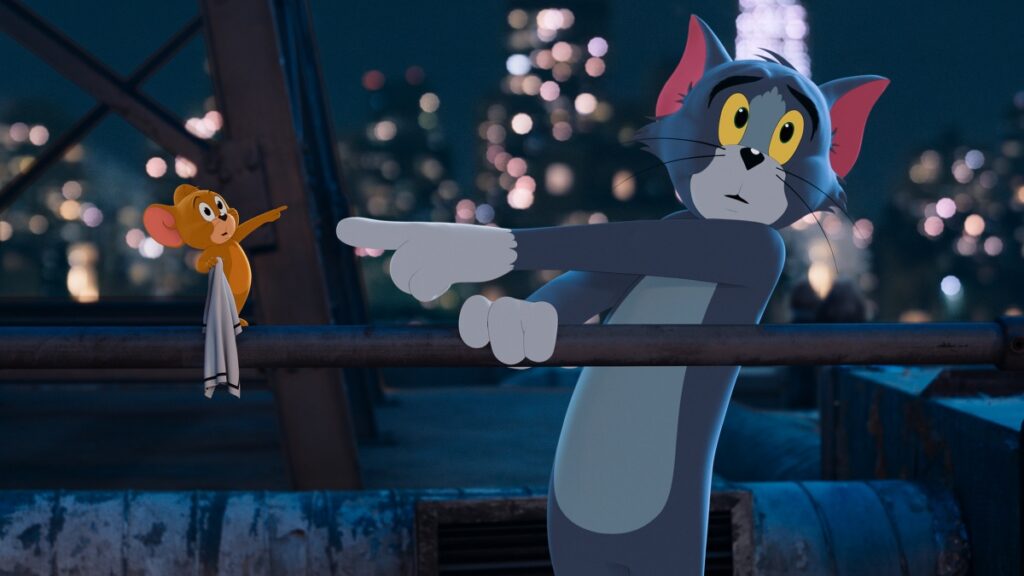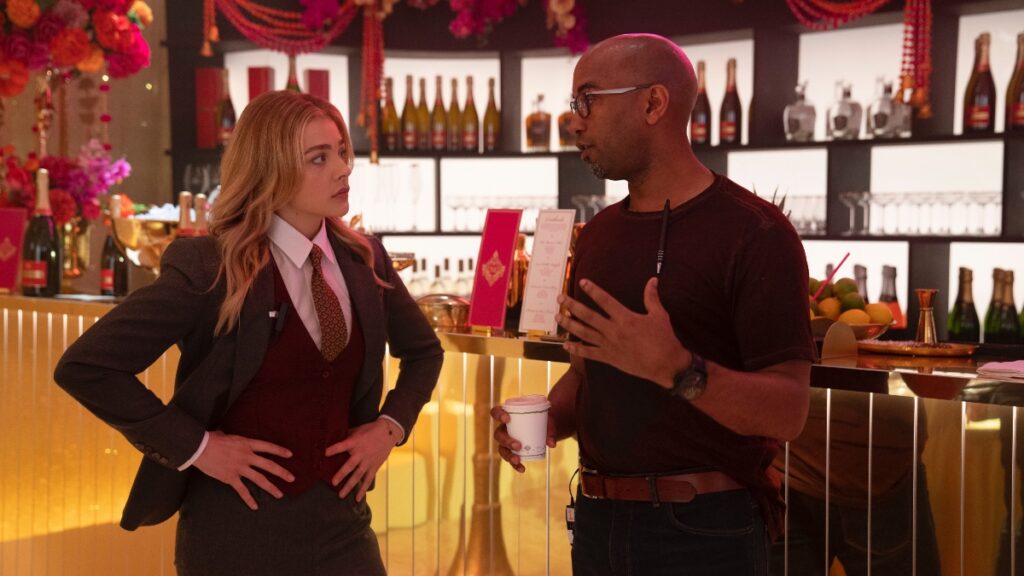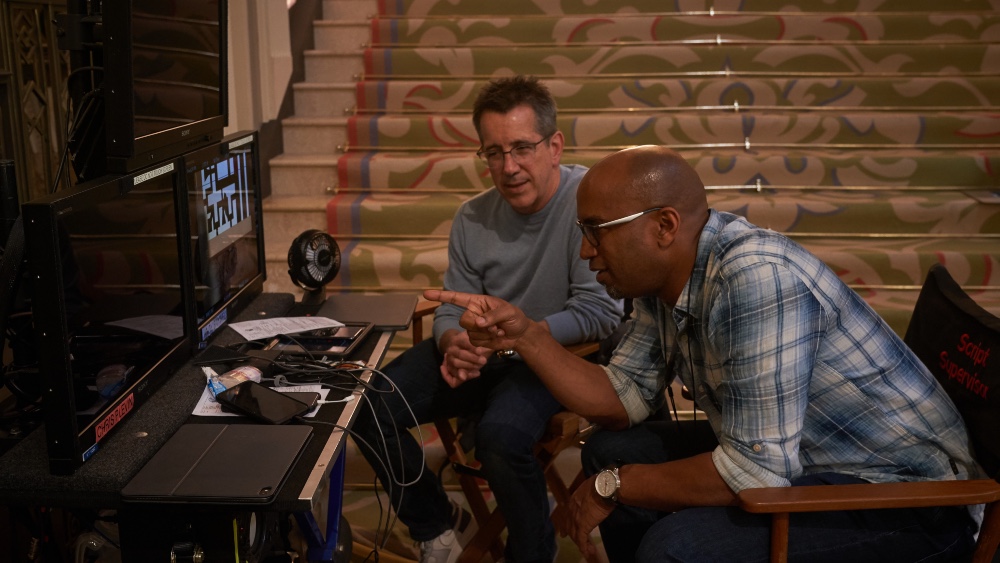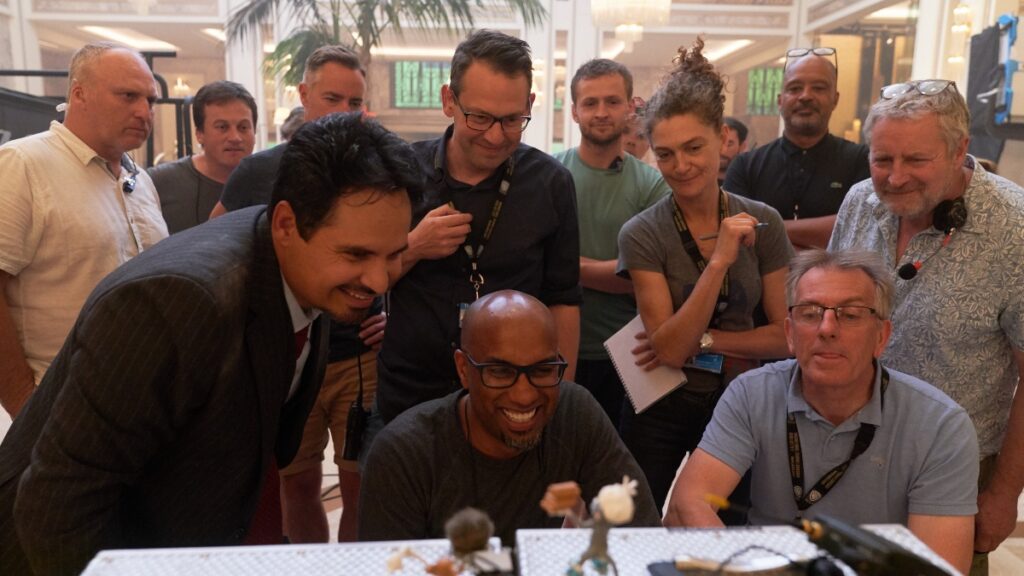
Director Tim Story has been making movies for over two decades, but it wasn’t until around 2002 when Story’s ability with comedy came to the forefront as he directed Ice Cube’s Barbershop in 2002. That was followed by the odd couple pairing of Jimmy Fallon and Queen Latifah for a remake of Luc Besson’s Taxi, and then a foray into superheroes with 2005’s Fantastic Four and its 2007 sequel.
Probably Story’s most productive and successful years took place between 2012 and 2016 when he teamed with Producer Will Packer for 2012’s Think Like a Man and 2014’s Ride Along, both starring Kevin Hart (the latter teaming him with Ice Cube), followed in quick succession with sequels to each of those. Those four movies alone made $450 million worldwide.
After trying to revive the classic Richard Roundtree character with Shaft, teaming him with the 2000 incarnation, played by Samuel L. Jackson and relative newcomer Jessie T. Usher, Story has remained in the world of existing IP (intellectual property) by taking on Hanna-Barbera’s cat-and-mouse nemeses, Tom & Jerry. Rather than being a straight-up animated movie, this is a hybrid of animation and live action with stars Chloë Grace Moretz, Michael Peña, Colin Jost and more, with the 2D Tom and Jerry integrated with the live actors in a way not dissimilar from Who Framed Roger Rabbit or Mary Poppins.
Below the Line spoke to the filmmaker last week to learn about what went into making this hybrid movie, and we were surprised to learn that the movie didn’t even shoot anywhere inside or even near a certain iconic New York City hotel that seems to be at the center of the movie.
BTL: What made you want to tackle a hybrid live-action/animated movie like Tom and Jerry?
Tim Story: First comes out of the love of just the characters. I grew up on these characters, watched them every day after school back when you didn’t have a choice of when stuff came. I just always loved them, and when it came up through Warner Brothers, I just read the script. The script was brilliant. It really captured everything — it was hilarious. It really found a way to merge these worlds, and like one of my favorite movies, Who Framed Roger Rabbit, this hybrid idea, it just kind of made me smile. I wanted to always get into animation, but it allows me to have the best of both worlds. I could still be in what I’m used to — comedy and shooting people on a set, so forth and so on — but also merge them with animation and visual effects. I just wanted to stretch as a director. I like to give myself challenges. When you feel like you know an IP and know it well, you feel like you can bring it some justice.
BTL: It still works in terms of being a cat and a mouse fighting. As long as you have that element, you’re in good shape. When you came on board, what were some of your first questions? Were you working with Warner Animation at first or were you doing your normal thing with the production designer and art department?
Story: One of the first questions was what were they expecting them to look like? I was a big fan of those cartoons, and there’s been other films in success that have also tried a different approach in terms of look, 3D, sometimes making them basically real inside the world and still just a cartoon look to them. But I was really interested in making sure that these characters look like the original material. By doing that, I think people would have a real nostalgia experience with the film, so that was important. And then of course, one of the other questions was going back and especially doing the research, Tom and Jerry were quite violent in terms of what they threw and destroyed and all this other stuff. I was concerned whether we were going to have to soften that too much, where it was unrecognizable. The great thing about it was that Warner Brothers said, “It’s gotta be what Tom and Jerry is.” We found other ways to make sure it wasn’t too harsh in terms of sound, but in terms of the the action, we went for it. I mean, there’s chainsaws, there’s all kinds of things in this movie and we just wanted to have real fun with recreating that.

BTL: I think the first time I interviewed Chloë Moretz, she was maybe 12 or 13 years old and she was doing all these R-rated movies that she wasn’t allowed to see, so it’s funny to see her grown up now and doing PG movies, kind of reversed.
Story: I was wanting her to do this really badly, because I kind of grew up on watching her movies. It was one of those things where you see all of these dramas she was always doing. I saw her in Neighbors 3, and thought, “This girl is really funny.” I thought for her to come into this property and do her thing would be refreshing for her, but also a really good look for us to see.
BTL: I really enjoyed seeing the Waldorf Astoria, because we’ve been in lockdown, and I haven’t been in midtown that much. I remember they shut down for remodeling a few years ago, and I wasn’t sure when they reopened. When did you get in there to make the movie?
Story: Here’s what warms my heart. That wasn’t actually the Waldorf Astoria. We couldn’t use any iconic place, because we were going to be destroying it, and they didn’t want that to be associated with their name, but we used that as a template for what we were going for. We took a lot of inspiration from it, because it was very important for us to give it this historic kind of location thing. It’s great that when we talked about hotels, that’s the one we kind of looked at and emulated to a certain degree, but we also took a lot of inspiration from some hotels in London as well. So we had a lot of fun with it.
BTL: You definitely fooled me as someone who has spent a lot of time there.
Story: I love that!
BTL: I assumed that you got into the Waldorf before they reopened and just shot the hell out of the place while you could.
Story: I’m so happy you said that. That made my day.
BTL: Did you shoot any of the movie in New York?
Story: No. Well, we did get a lot of plates, so we actually had people on the ground shooting a lot of stuff, but all of it was shot in London. I never rolled camera in New York, and it’s kind of a testament to visual effects and what you can pull off. We took a backlot in London and converted it into New York — only about two stories up, but from there, we added on the rest of New York. As you say, when I’m fooling New Yorkers, I’m really happy. [laughs]
BTL: It was a part of New York that I hadn’t seen for over a year, so it’s wild to see that. You worked with Alan Stewart as your DP, and I know he did Guy Ritchie’s Aladdin, so I know he has a good handle on VFX-driven stuff. What were some of the considerations you were dealing with when dealing with the fact that two of the three stars were going to be animated?
Story: We wanted to be sure we shot them like we would any actors. Even though Jerry is six inches high, or whatever it is, or Tom is three feet, we wanted to do things like over the shoulder shots. One thing about the original material is they were always on one plane, or they were always in profile. We wanted to be sure that we got down on the ground in what we would sometimes call “Jerry Cam.” Get down on the ground and do it from his perspective. Or if someone is talking to Tom, do a shot over that actor towards Tom. We wanted to be sure that we treated them like actors.
Then when it came to action, what’s fun about it is Tom and Jerry was always kind of one way. They had to tell a lot of story in one big wide shot; we wanted to make it a point to be wide and tight and kind of give movement. Since we were going to be taking these characters into a 3D world — even though we were going to keep them 2D or 2D plus, we wanted to be sure [we had] other angles that you’ve never seen them in. We wanted to see them spin around and the camera go around them 180, and kind of just give you different looks on it. We sometimes found that in certain angles, Tom didn’t look like Tom or Jerry didn’t look like Jerry. With our software that recreated some of the hand drawn lines that we had from the old cartoons, we would have to go in there, and sometimes, the artist would have to actually sketch out and make the model that we had in the 3D computer world look more like the 2D animation. So there was a lot of these considerations given to making sure these characters looked familiar to so many fans out there that love the product.

BTL: Were you able to have some sort of pre-visual or something similar you could use on set so that those actors would know what they were reacting to?
Story: Whenever I’ve done action in my action-comedies or the Fan 4 movies, you have to do a lot of preparation. Here, we had to literally, not only do the action in storyboard and pre-vis, we also had to, in some ways, do everything the characters were going to do, so that once we got onto the set, we could actually show the actors, “Here’s what we’re thinking.” But we were kind of fluid in the event somebody said, as we lined up the shot, “Hey, can Jerry be on the desk, as opposed to on the chair?” Then our animation supervisor was close and it’s like, “Sure.” “Great.” So we would do things like that, and we found that we had a lot of freedom. Then of course, once you got into post, it started all over again. Even though we had ideas for Jerry and Tom to do a certain thing, now it became, “Okay, is that the best idea?” There are some scenes in the movie that we created from scratch. They weren’t even in the script, and we just had an idea and started creating that idea. Tom flying in the sky and doing all of that stuff, none of that was scripted. We just got inspired one day and all these shots ended up being what they are.
BTL: Can you generally do almost anything? You have a big chase scene on the streets of New York, so are you able to shoot things like that and know the animation and VFX departments can make it work?
Story: The only thing that you sometimes have to be concerned about is if certain people are walking in front of objects that you actually don’t have the information for, where they might cut off something or if you were going to ramp speed, you don’t want people to look like they’re walking fast or too slow, or this and that. Sometimes, whenever we could, you can obviously get that stuff out of your way, but for the most part, I had freedom to do anything I wanted. If I wanted the streets of New York to be empty, as long as I’ve got frames of each part of that street at one point, I could do it. The truck going around New York, many times that truck was CG, which allowed me to kind of move here. When we did the skateboard chase, anything I wanted to create, we did. We did do footage down the streets of New York, but in no part were we moving faster than 35 miles an hour or whatever it is. Here, we could, by having photography and a bunch of CG cars, we could kind of create everything we wanted to. We’re just in a world now where the only limitation is your creativity.
BTL: You had already done some big VFX movies with the Fantastic 4 movies, as you mentioned. Did you treat the animation department sort of like dealing with VFX, or did you have a separate animation and then VFX as well? Or were they combined?
Story: I guess for the Fan 4 movies, we wouldn’t really consider any of that animation, at the time, but it did go through the same workflow. But when we started creating the character of the Silver Surfer, those moments were obviously a completely CGI character, and it was kind of like those types of freedoms. Me having that experience, it does give you the confidence that nobody in the room can tell you, “Hey, we can’t do that.” We don’t even have those conversations anymore. It’s just how much money and how much time do we have.
It made it really fun that you can go into a film like this, and just think, “Hey, at some point, I want to be down on the deck of that skateboard going through,” or “I want butterflies everywhere” or “I want elephants,” and all we have to do is create on set where we’re pulling over tables, and this and that. That interaction, you’re just looking for ways for it to look more and more real, because when it came to the reality world, we knew that the more we can do in camera, the better the animation characters were going to appear.

BTL: I really do like the choice to go 2D, because while Roger Rabbit is a great reference, so is the original Mary Poppins, and they did that in the ‘60s when they didn’t have computers.
Story: They literally drew on the cells. Incredible, incredible!
BTL: If someone ever figures out how to revive Walt Disney, he would flip out.
Story: He’d be freaking out, and he’d also probably be pissed off. He’d say, “Do you know how long it took me to do this?”
BTL: I want to ask about some of the other people you worked with on this. Peter Elliot is an editor you’ve worked with for many years on many movies, so obviously, you’re going to have a shorthand when you’re working with him again. Is he someone you’re sending stuff to as you’re shooting to edit as you go along?
Story: Yeah, with any editors I would work with, Peter Elliot, we have such a shorthand that as soon as I get a script that I’m thinking about making, I send it to him. We discuss early on ideas I have and just kind of anything that when I bounce it against him, he’ll tell me, “Oh, have you thought about it this way or that way?” because later on, he’s gonna have to take that material and put it together. Peter has always been a great collaborator of mine. He’s also a great friend, but also a very creative and talented editor. I’ve found that by having him next to me doing these projects, we’ve never said, “We can’t.” He has just such an incredible way of solving problems, and so much of filmmaking is that at some point, you’ve gotta plan. You got something that you want to accomplish, and then now it just becomes, “How do we do it?” Peter, who has also worked on some of the biggest Marvel movies, he just knows this world. Now that I’ve gotten back into more of the visual effects space, he’s such a confidante and somebody that I just depend on as I go forward.
BTL: But also for comedy, timing is everything, and if one thing is off or you cut to something too slow it wouldn’t work at all.
Story: Just knowing the rules of reactions, you can make so many things funny just by cutting somebody looking crazy. Like, what the hell are they doing? It all of a sudden becomes funny, because in context, you go there. It’s really fun when you have somebody that gets my style of comedy as well. Whenever I send him a bunch of material, he can just go for it, he doesn’t have to ask me a lot of questions, especially when it comes to that first cut.
BTL: Going back to what I thought was the Waldorf, how did you decide with your Production Designer how to create that hotel, especially considering all of the elements that have to come together later?
Story: It was fun to walk into the production design offices and just kind of see what we had stuck up on all this. We put so many different pictures of so many different hotels, and it’s fun to just really think in theory at first. “Would it be cool if this was ornate?” But then you also have to couple that back with…
I wanted a lot of muted Browns at some point, but then I also found that Jerry is brown and is that going to clash with how he’s gonna look. Any blue that we picked that was going to be on set, we had to also put that up against, “Okay, what is our color palette for Tom? How blue or gray is he gonna be in certain shots?” And kind of see, how do we make sure that our characters are going to pop onto the set.
As we were talking before about design, there’s a homage to the older world that we wanted to bring. There’s a famous short where Jerry goes to Manhattan – I think it’s called “Mouse in Manhattan” — and he goes to Manhattan, and he sees New York for the first time and the skyscrapers. We wanted to be sure that we were able to kind of recreate the sense of that. We really just did a lot of research, but at the same time making sure we’re making a film that is up to date and will resonate with Millennials and young kids. I forget all the “Gens” we’re on now – Gen Z – at some point we’ll start over on Gen A, but it’s really fun to do this process.
BTL: Are you prepping something else to do next? Obviously, COVID has sidelined a lot of projects, but I assume you did a lot of the post on Tom and Jerry during COVID.
Story: We did a lot of post in COVID, and I must admit at some point, we were down for about two weeks, but once everybody got remotely into their zone, I found it quite fun actually that you could roll out of bed, go to work for how many hours, and roll back. What I’m looking at is I have a film over at Universal called “Terrible Twos,” another quote-unquote hybrid movie, as well as I’m developing Corduroy. I don’t know if you remember the little bear that was a big children’s book, and I’m off to Atlanta now to go do a pilot for ABC. It’s getting kind of kind of crazy here, but I’m having a good time.
BTL: Have you started your prep for the COVID protocols, social distancing and all of that?
Story: Tested today. I’ll get tested on Friday before I leave, and it’s just our new normal, man. You just gotta, ya know?
Tom & Jerry will open in select theaters in North America and in other countries, but it will also be available on HBO Max for its first month.
All photos courtesy of Warner Bros. Pictures.





